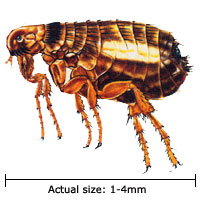

Treatments For Fleas:
There are many powders, dips, sprays and shampoos available to prevent and treat flea infestation. You can also contact your vet for long term anti-flea treatments that are given orally, and usually last for a month. Most vets believe that flea collars are not an effective way to fight fleas. See the flea treatments page for more information, and the best prices available.
Flea Treatments Not Working?
If your dog still has a problem with fleas even after a veterinarian's treatment, the problem may be its environment. Make regular checks of your rugs (very popular with fleas), couches, and blankets. Be sure to check your dog's bed as well, and wash any blankets or sheets with hot water. "Flea Bombs" are available at your local pet store or pharmacy, and are effective at eliminating small infestations. If this still does not solve your problem, you may have no choice but to call an exterminator.
There are many powders, dips, sprays and shampoos available to prevent and treat flea infestation. You can also contact your vet for long term anti-flea treatments that are given orally, and usually last for a month. Most vets believe that flea collars are not an effective way to fight fleas. See the flea treatments page for more information, and the best prices available.
Flea Treatments Not Working?
If your dog still has a problem with fleas even after a veterinarian's treatment, the problem may be its environment. Make regular checks of your rugs (very popular with fleas), couches, and blankets. Be sure to check your dog's bed as well, and wash any blankets or sheets with hot water. "Flea Bombs" are available at your local pet store or pharmacy, and are effective at eliminating small infestations. If this still does not solve your problem, you may have no choice but to call an exterminator.
Never underestimate the tiny flea. Not only do they suck your dog's blood, but they are responsible for the spread of many human diseases and afflictions from allergies to the black plague. They reproduce at astounding speeds if left unchecked. Severe cases can even lead to a pet's death.

Prevention And Cures For Fleas And Ticks In Dogs:
Don't Forget Ticks!
While searching for fleas, you should also search for ticks (right). Ticks like to attach themselves to the warm parts of animals, such as the shoulders, ears, necks, crotch, and between the toes. They will drink blood until satisfied, then drop off thousands of eggs before going on their merry way. Using gloves, pull the ticks off one at a time with a pair of tweezers. You can also use vaseline smeared over the ticks to suffocate them. Be sure to check your dog's infected areas for a few days afterwards, to be sure none of the bites become infected. You can also contact your veterinarian for a special "tick bath" or "medicated dip" procedure that can be quite effective.
While searching for fleas, you should also search for ticks (right). Ticks like to attach themselves to the warm parts of animals, such as the shoulders, ears, necks, crotch, and between the toes. They will drink blood until satisfied, then drop off thousands of eggs before going on their merry way. Using gloves, pull the ticks off one at a time with a pair of tweezers. You can also use vaseline smeared over the ticks to suffocate them. Be sure to check your dog's infected areas for a few days afterwards, to be sure none of the bites become infected. You can also contact your veterinarian for a special "tick bath" or "medicated dip" procedure that can be quite effective.

How To Search Your Dog For Fleas:
Obvious scratching and self biting are a good indicator your dog has fleas. To confirm flea infestation in your dog, place him or her over a large white piece of paper or sheet. Using a pair of gloves, gently brush and part your dog's fur, searching common infestion areas like the stomach, chest, anus, and tail areas. If fleas are present, they and their "debris" will tend to fall on the paper and be quite visible against the white background.
Obvious scratching and self biting are a good indicator your dog has fleas. To confirm flea infestation in your dog, place him or her over a large white piece of paper or sheet. Using a pair of gloves, gently brush and part your dog's fur, searching common infestion areas like the stomach, chest, anus, and tail areas. If fleas are present, they and their "debris" will tend to fall on the paper and be quite visible against the white background.
Pet Meds: Dogs | Pet Meds: Cats | Dog Health : By Breed | Cat Health : By Breed | Dog Grooming | Cat Grooming | Pet Top 10's | Pet Food Recipes
Pet Meds: Dogs Pet Meds: Cats Common Dog Health Issues Common Cat Health Issues Dog Grooming Cat Grooming Pet Top 10's
Pet Health:Home
Copyright 2006-2011 PetMedsOnline.Org
Online Store For Dogs!
Find everything from basic grooming items and tasty treats, to high tech devices designed for pets!
Find everything from basic grooming items and tasty treats, to high tech devices designed for pets!
Pet Top Lists!
From the friendliest cat breeds to the most intelligent dogs, you'll find it all on our "pet top list" pages!
From the friendliest cat breeds to the most intelligent dogs, you'll find it all on our "pet top list" pages!

